 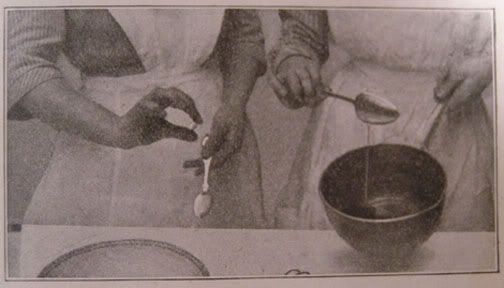 I’m really having fun going through my grandmother’s “Domestic Science Books I and II” book. Having been published in 1914, you can imagine the photos of women in their sleeved, long dresses and taylored, floor-length, white aprons, primly tied at tiny waists. I feel very happy to see that my short, work-worn fingernails look exactly like theirs. Evidently, women, back then, didn’t worry about French tips or painted designs on their fingernails, either. At the beginning of book II of this wonderful home living manual, I came across the following poem, by Owen Meredith. It is so ridiculous, I have to post it. Obviously, this Owen guy would have benefitted from today’s Overeater’s Anonymous. He seems to have been so focused on eating that all else was trivial to him! You be the judge: O hour of all hours, the most bless’d upon earth, Blessed hour of our dinners! * We may live without poetry, music, and art, We may live without conscience, and live without heart; We may live without friends; we may live without books; But civilized man cannot live without cooks. He may live without books – what is knowledge but grieving? He may live without hope – what is hope but deceiving? He may live without love – what is passion but pining? But where is the man that can live without dining? – Owen Meredith Makes you hungry, huh? Well, I’ll solve that problem and share another lesson in recipe from days gone by, which would be easy to cook on your wood cook stove! You can pretend! I will be giving the recipe for their dumplings, which are the type that are fluffy and soft. We southerners like flat dumplings or oval ones that are more like noodle dough. And so, while I’ll give you the recipe the book suggests, I’ll show you the pictures and recipe for the dumplings that I make. And of course, at the end, just as in the book, I’ll post those rules for table manners ala 1914. So stoke up the fire…. 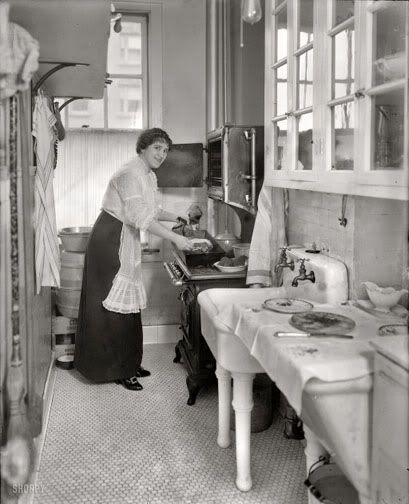 3 lbs beef – preferably round roast 1 tblsp butter 2 tblsp flour 2 onions sliced 1 carrot 4 potatoes water or beef stock salt and pepper 1 turnip (optional) Dumplings 2 cups flour 4 tsp baking powder 1 tsp salt 3/4 cup water or milk Sift the dry ingredients together; add the liquid gradually. Drop by the spoonful upon the stew and cook until done. 1 cup all-purpose flour 1 egg 1 tsp baking powder 1/4 cup water or milk 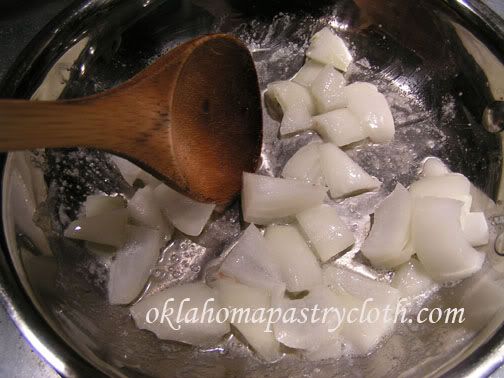 Cut the roast into 1″ cubes and toss meat in flour. I used my canned rump roast (what can I say? Rump roast was on sale, cheap!) and cubed that. Sauté onions in butter and add beef to brown. 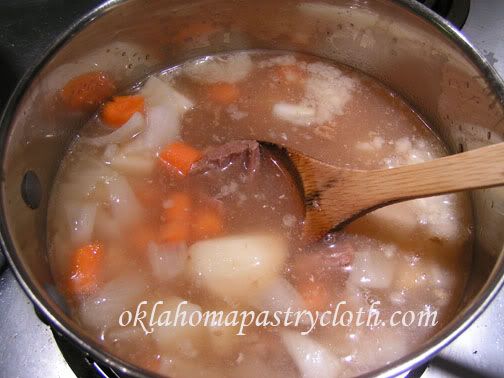 Add water or beef stock (I used stock) and simmer for at least an hour to an hour and a half until meat is tender. Add chopped carrots, potatoes and chopped turnip (optional) and cook 45 minutes longer. 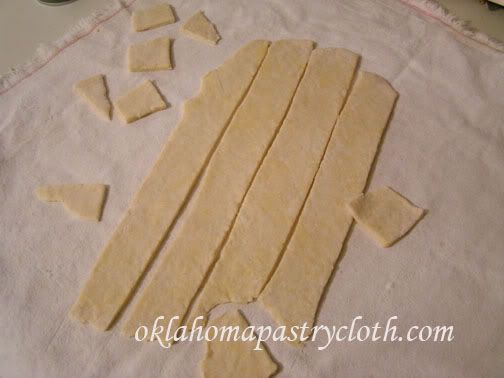 Mix ingredients together for dumplings, using just enough water to form a dough ball. Roll out onto your Oklahoma Pastry Cloth™ and slice in 1″ strips. Slice strips across to form 1″ squares. 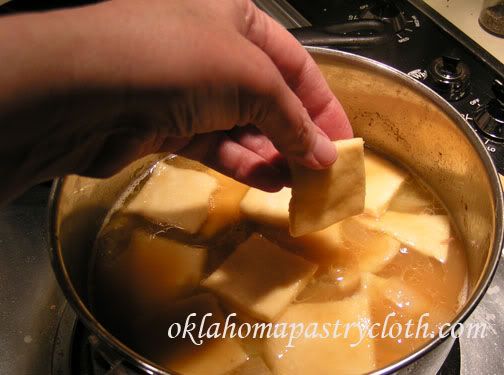 Bring stew to a boil and place dumplings on top of broth. 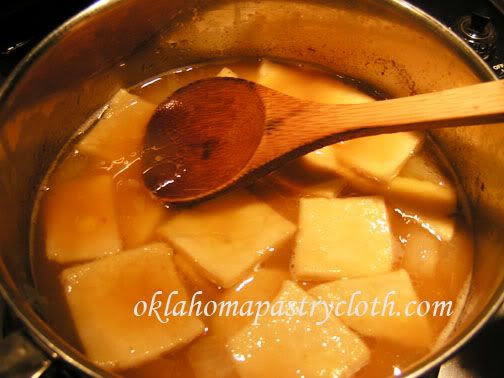 With spoon, gently press dumplings into broth to cover. Simmer for 20 minutes until tender. 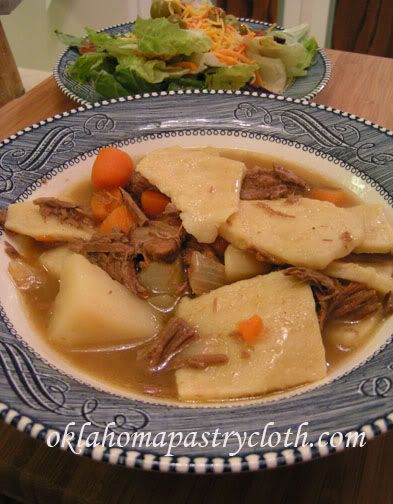 Serve with salad and cornbread or fresh bread and dig in. It’s simple! Table manners: Do not hold the knife and fork upright on the table. The knife and fork when used for cutting should be held with the fork, tines down, in the left hand and the knife in the right hand, the handles in the hollows of the hands. Do not open the mouth to receive food until the food reaches the mouth. Always eat or sip from the side of the spoon. The napkin should never be tucked in the collar. Happy Vintage Cooking!  |
|
|
Oklahoma Pastry Cloth™ Company on Facebook
|
|
 |
|
|
Posts Tagged ‘beef stew’
Vintage Cooking Pt 2
Thursday, January 12th, 2012
Canning Beef Stew
Tuesday, July 12th, 2011
 How hot is it? It is so hot in Oklahoma the snakes are looking for air conditioning and they’re cold blooded!! It so hot here that the nectarines are going straight from the tree into jars as jam. It’s so hot that the Gila Monsters have moved to Oklahoma from the Mohave Desert because it’s warmer here! Yeah, we’re setting records. The disturbing news for the rest of you is what this is doing to part of your food supply. Grain and cotton crops have simply burned up, causing both to rise in price. As a result, grain is becoming cost prohibitive for ranchers for their livestock. Grass is gone and so many ranchers are having to resort to expensive hay as well. I just talked with a friend, in south-central Oklahoma, who owns a very large cattle ranch and she said they are preparing to sell their entire herd of cows. She said the cows are losing weight so fast that they must be sold this week or she and her family will take an even worse beating. There is no grass and there is no water. I see cheap beef in the grocery stores in the shortrun, from ranchers selling off herds, and a shortage of beef/high prices in the longrun, so plan accordingly!! One would think that in this furnace that is the midwest, one wouldn’t even think of hot meals. But planning ahead is the stuff that makes us prairie folk able to contend with the unexpected. Using garden staples that have managed to survive to can foods for the winter is a great way to use these days indoors. I have been finding beef on sale and so, I’ve been putting up a Fall and Winter supply of beef stew, a veritable meal in a jar! Just open a jar, heat the stew in a pot, mix up a batch of cornbread and you’ve got supper! And if the electricty goes out in one of our famous ice storms, the wood stove or the grill make perfect heat sources for a pot of stew accompanied by bread or crackers. So here is how I do my beef stew for Mr. Fix-It. He loves having this around because he can fix it himself! (carrots, celery, potatoes, onion, etc)
 Pat 10 lbs of meat dry with paper towel. I use either chuck roast or rump roast, depending on what’s on sale. Today I’m using chuck roast.  This is a rump roast. If you will notice, the chuck roast has more fat and more loss, but it is also more flaky.  Cut meat into cubes  Remove fat and membranes by lifting as you cut underneath. As you lift, this gives more area to slice under the membrane or fat and also helps to release them from the meat.  Lightly salt the meat  Add a little of the meat at a time to a very large stock pot that is on medium heat. Brown and add more meat until most meat cubes are lightly browned on at least one side. Juices will begin releasing.  Add 4 1/2 pounds of mixed veggies. I am using potatoes, carrots, onions and celery. You can use whatever amounts of each that you prefer and you can add other vegetables according to taste.  Add water to cover  Add garlic powder  Add thyme  Add bay leaf  Add beef bouillon  Mix package of brown gravy with 1/2 cup water and add to the stew, stirring. At this point, if you like wine or burgandy in your beef stew, add 1/2 cup. Mr. Fix-It likes his without.  Cover and allow to simmer vigorously 1 hour, adding water to keep at the same level and stirring occassionally to keep from sticking.  Mix 1/2 cup corn starch with one cup of cold water. I start out with this much and add more if I need more thickening. I usually wind up using 3/4 cup corn starch with 1 1/2 cup water, however, I like to start out with less and adding more if needed. Do not make the broth too thick. It can always be reduced after opening a jar and bringing to a boil. If you get your broth too thick, it will thicken more in the processing and will become way too thick.  Stir continually as you pour into boiling stew broth to keep from lumping.  Find and remove bay leaf. Place stew into jars, dividing broth evenly between jars. Leave 1″ headspace.  Using a canning spatula or knife, remove any air bubbles by running around the inside perimeter of the jars.  Wipe the rims of the jars to remove any juices or oils  Add lids that have been warming in a pan of nearly boiling water  Add rings, tightening and then backing off just a hair  Place jars into canner, cover and process for 1 hour 30 minutes for quarts and 1 hour 15 minutes for pints at 10 lbs of pressure  Meanwhile, place all the trimmings into a pot and cover with water. Boil until trimmings are cooked down to very tender, continually adding water as needed. Strain broth from the trimmings and add broth to pint jars. Add 1/2 tsp salt to each pint and process with any extra jars of beef stew to make canned beef broth.  Place trimmings, a carrot and about 1/4 cup oatmeal into food processor or blender and turn into a puree. You can put this into jars too, with extra water, leaving 1 inch of head space to can. Or you can freeze it. Use it as canned dog food! Nothing has been wasted. |
|
Oklahoma Pastry Cloth™ Company on Facebook
|
 |

 Homestead Revival
Homestead Revival Paratus Familia
Paratus Familia Rural Revolution
Rural Revolution